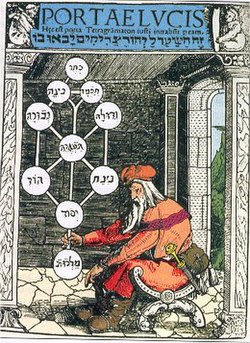
Back Kabbala Afrikaans Kabbala ALS قبالة (يهودية) Arabic كابالا ARZ Kabbala Azerbaijani Kabbalah BAR Кабала Byelorussian Кабала BE-X-OLD Кабала Bulgarian Kabbala Breton
Bu madde veya bölüm Kabalacılık adlı maddeye çok benzemektedir ve bu iki maddenin tek başlık altında birleştirilmesi önerilmektedir. Birleştirme işlemi yapıldıktan sonra sayfaya {{Geçmiş birleştir}} şablonunu ekleyiniz. |
| Makale serilerinden Yahudiler ve Yahudilik |
|---|
 |
| Etimoloji • Kim bir Yahudi'dir? |

Kabala (İbranice: קַבָּלָה, lit. "gelenek"[1] veya 'yazışma')[2] veya Kabbalah, Yahudi mistisizminde ezoterik bir disiplin, düşünce okulu veya kurallar bütünüdür.[3] Yahudilik'te üyelerine מְקוּבָּל [Kabaliste Mequbbāl] denir.[3] Kabala'nın tanımı, onu takip edenlerin geleneğine ve amaçlarına göre değişiklik gösterir.[4] Kabala, Yahudiliğin ilk yıllarına kadar uzanır; öyle ki, Hristiyanlığı kuran ilk Yahudilerden, Hristiyanlığa da geçmiştir (Hristiyan Kabala).[3][5][6] Yahudilik içindeki mistik dinî yorumların temelini oluşturur. Yahudi Kabalalar, değişmeyen, sonsuz ve ebedi Tanrı'ları Yehova'nın gizemi Ein Sof'u (אֵין סוֹף; anlamı "Sonsuz") ve ölümlü, sonu olan Evren'in arasındaki ilişkiyi felsefî bir şekilde araştıran bir dizi ezoterik Yahudi öğretileridir.[3][5][7]
- ^ "קַבָּלָה". /www.morfix.co.il. Melingo Ltd. 26 Mart 2016 tarihinde kaynağından arşivlendi. Erişim tarihi: 19 Kasım 2014.
- ^ Wyn, s. 3.
- ^ a b c d Ginzberg, Louis; Kohler, Kaufmann (1906). "Cabala". Jewish Encyclopedia. Kopelman Foundation. 4 Kasım 2011 tarihinde kaynağından arşivlendi. Erişim tarihi: 23 Ekim 2018.
- ^ Dan, Joseph (2007). "The Term and Its Meanings". Kabbalah: A Very Short Introduction. New York: en:Oxford University Press. ss. 1-11. ISBN 978-0-19-530034-5.
- ^ a b "Ein-Sof". en:Jewish Virtual Library. AICE. 2018. 2 Şubat 2017 tarihinde kaynağından arşivlendi. Erişim tarihi: 25 Haziran 2020.
EIN-SOF (Heb. אֵין סוֹף; "The Infinite," lit. that which is boundless), name given in Kabbalah to God transcendent, in His pure essence: God in Himself, apart from His relationship to the created world. Since every name which was given to God referred of the characteristics or attributes by which He revealed Himself to His creatures, or which they ascribed to Him, there is no name or epithet for God from the point of view of His own being. Consequently, when the kabbalists wanted to be precise in their language they abstained from using names like Elohim, the en:Tetragrammaton, "the Holy One, blessed be He," and others. These names are all found either in the Written or the Oral Law. The Torah, however, refers only to God's manifestations and not to God's own being which is above and beyond His relationship to the created world. Therefore, neither in the Bible, nor in rabbinic tradition was there a term which could fulfill the need of the kabbalists in their speculations on the nature of God. "Know that Ein-Sof is not alluded to either in the Pentateuch, the Prophets, or the Hagiographa, nor in the writings of the rabbis. But the mystics had a vague tradition about it" (Sefer Ma'arekhet ha-Elohut). The term Ein-Sof is found in kabbalistic literature after 1200.
- ^ "אינסוף". Morfix™, ™מורפיקס. Melingo Ltd. 27 Şubat 2019 tarihinde kaynağından arşivlendi. Erişim tarihi: 19 Kasım 2014.
- ^ Dennis, Geoffrey W. (18 Haziran 2014). "What is Kabbalah?". ReformJudaism.org. en:Union for Reform Judaism. 25 Nisan 2015 tarihinde kaynağından arşivlendi. Erişim tarihi: 25 Ekim 2018.
Historians of Judaism identify many schools of Jewish esotericism across time, each with its own unique interests and beliefs. Technically, the term “Kabbalah” applies only to writings that emerged in medieval Spain and southern France beginning in the 13th century. [...] Although until today Kabbalah has been the practice of select Jewish “circles,” most of what we know about it comes from the many literary works that have been recognized as “mystical” or “esoteric.” From these mystical works, scholars have identified many distinctive mystical schools, including the Hechalot mystics, the German Pietists, the Zoharic Kabbalah, the ecstatic school of Abraham Abulafia, the teachings of Isaac Luria, and Chasidism. These schools can be categorized further based on individual masters and their disciples.
